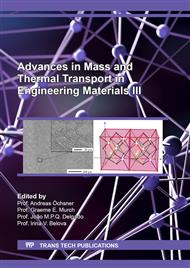[1]
Kraytsberg, A., and Ein-Eli, Y. (2014). Review of advanced materials for proton exchange membrane fuel cells. Energy & Fuels, 28(12), 7303-7330.
DOI: 10.1021/ef501977k
Google Scholar
[2]
Cano, Z. P., Banham, D., Ye, S., Hintennach, A., Lu, J., Fowler, M., and Chen, Z. (2018). Batteries and fuel cells for emerging electric vehicle markets. Nature Energy, 3(4), 279-289.
DOI: 10.1038/s41560-018-0108-1
Google Scholar
[3]
https://www.hyundaiusa.com/us/en/vehicles/nexo.; https://www.toyota.com/mirai/fcv.html.; https://automobiles.honda.com/clarity-fuel-cell.
Google Scholar
[4]
Debe, M. K. (2012). Electrocatalyst approaches and challenges for automotive fuel cells. Nature, 486(7401), 43-51.
DOI: 10.1038/nature11115
Google Scholar
[5]
Gasteiger, H. A., Kocha, S. S., Sompalli, B., and Wagner, F. T. (2005). Activity benchmarks and requirements for Pt, Pt-alloy, and non-Pt oxygen reduction catalysts for PEMFCs. Applied Catalysis B: Environmental, 56(1-2), 9-35.
DOI: 10.1016/j.apcatb.2004.06.021
Google Scholar
[6]
Okonkwo, P. C., Ige, O. O., Uzoma, P. C., Emori, W., Benamor, A., and Abdullah, A. M. (2021). Platinum degradation mechanisms in proton exchange membrane fuel cell (PEMFC) system: A review. International Journal of Hydrogen Energy, 46(29), 15850-15865.
DOI: 10.1016/j.ijhydene.2021.02.078
Google Scholar
[7]
Meier, J. C., Galeano, C., Katsounaros, I., Witte, J., Bongard, H. J., Topalov, A. A., ... and Mayrhofer, K. J. (2014). Design criteria for stable Pt/C fuel cell catalysts. Beilstein journal of nanotechnology, 5(1), 44-67.
DOI: 10.3762/bjnano.5.5
Google Scholar
[8]
Meyers, J. P. and Darling, R. M. (2006). Model of carbon corrosion in PEM fuel cells. Journal of the Electrochemical Society, 153(8), A1432.
DOI: 10.1149/1.2203811
Google Scholar
[9]
Martens, S., Asen, L., Ercolano, G., Dionigi, F., Zalitis, C., Hawkins, A., ... and Schneider, O. (2018). A comparison of rotating disc electrode, floating electrode technique and membrane electrode assembly measurements for catalyst testing. Journal of Power Sources, 392, 274-284.
DOI: 10.1016/j.jpowsour.2018.04.084
Google Scholar
[10]
Mayrhofer, K. J. J., Strmcnik, D., Blizanac, B. B., Stamenkovic, V., Arenz, M., and Markovic, N. M. (2008). Measurement of oxygen reduction activities via the rotating disc electrode method: From Pt model surfaces to carbon-supported high surface area catalysts. Electrochimica Acta, 53(7), 3181-3188.
DOI: 10.1016/j.electacta.2007.11.057
Google Scholar
[11]
Garsany, Y., Baturina, O. A., Swider-Lyons, K. E. and Kocha, S. S. (2010). Experimental methods for quantifying the activity of platinum electrocatalysts for the oxygen reduction reaction. Analytical Chemistry, 82, 6321-6328.
DOI: 10.1021/ac100306c
Google Scholar
[12]
Borup, R. L., Kusoglu, A., Neyerlin, K. C., Mukundan, R., Ahluwalia, R. K., Cullen, D. A., and Myers, D. J. (2020). Recent developments in catalyst-related PEM fuel cell durability. Current Opinion in Electrochemistry, 21, 192-200.
DOI: 10.1016/j.coelec.2020.02.007
Google Scholar
[13]
Bai, J., Ke, S., Song, J., Wang, K., Sun, C., Zhang, J. and Dou, M. (2022). Surface Engineering of Carbon-Supported Platinum as a Route to Electrocatalysts with Superior Durability and Activity for PEMFC Cathodes. ACS Applied Materials & Interfaces, 14(4), 5287-5297.
DOI: 10.1021/acsami.1c20823
Google Scholar
[14]
Zhang, Y., Chen, S., Wang, Y., Ding, W., Wu, R., Li, L., ... and Wei, Z. (2015). Study of the degradation mechanisms of carbon-supported platinum fuel cells catalyst via different accelerated stress test. Journal of Power Sources, 273, 62-69.
DOI: 10.1016/j.jpowsour.2014.09.012
Google Scholar
[15]
Poidevin, C., Paciok, P., Heggen, M., and Auer, A. A. (2019). High resolution transmission electron microscopy and electronic structure theory investigation of platinum nanoparticles on carbon black. The Journal of Chemical Physics, 150(4), 041705.
DOI: 10.1063/1.5047666
Google Scholar
[16]
Mayrhofer, K. J., Hanzlik, M., and Arenz, M. (2009). The influence of electrochemical annealing in CO saturated solution on the catalytic activity of Pt nanoparticles. Electrochimica acta, 54(22), 5018-5022.
DOI: 10.1016/j.electacta.2009.01.079
Google Scholar
[17]
Schlögl, K., Mayrhofer, K. J., Hanzlik, M., and Arenz, M. (2011). Identical-location TEM investigations of Pt/C electrocatalyst degradation at elevated temperatures. Journal of Electroanalytical Chemistry, 662(2), 355-360.
DOI: 10.1016/j.jelechem.2011.09.003
Google Scholar
[18]
Hodnik, N. and Cherevko, S. (2019). Spot the difference at the nanoscale: identical location electron microscopy in electrocatalysis. Current opinion in electrochemistry, 15, 73-82.
DOI: 10.1016/j.coelec.2019.03.007
Google Scholar
[19]
Dubau, L., Castanheira, L., Berthomé, G. and Maillard, F. (2013). An identical-location transmission electron microscopy study on the degradation of Pt/C nanoparticles under oxidizing, reducing and neutral atmosphere. Electrochimica Acta, 110, 273-281.
DOI: 10.1016/j.electacta.2013.03.184
Google Scholar


